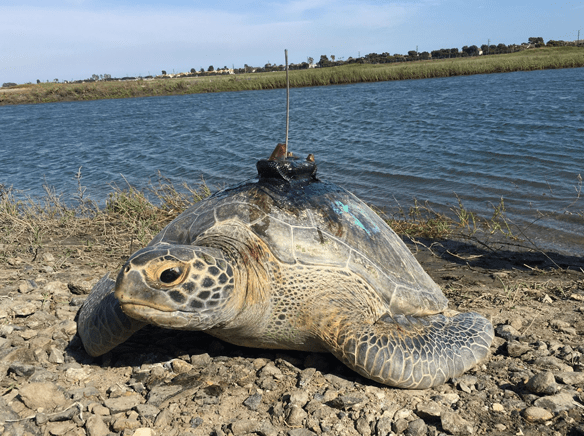By Marty Golden
For the Sun
Did you know there are quite a few green sea turtles living in the area around Seal Beach? The turtles are listed as a threatened species under the U.S. Endangered Species Act, but you can see them most any day if you know where to look. One of my favorite spots to look for them is on the bicycle trail along the San Gabriel River between the two power plants – they like the warm water there.
The best time to see them is when there is little wind; just wait for their heads to pop-up. The turtles need to breathe, so they must surface every few minutes when they are active, although they can stay submerged for several hours when resting. The largest green sea turtle ever recorded in the Eastern Pacific was 540 pounds, but most adults are between 240 and 420 pounds.
The greatest abundance of green sea turtles in northern Orange County appears to be in the San Gabriel River and the salt marshes of the Seal Beach National Wildlife Refuge (located inside the Seal Beach Naval Weapons Station). NOAA Fisheries Service in cooperation with the Refuge, Navy, and local universities has been conducting research on the Refuge for about 8 years.
Since the research began, they’ve identified at least 47 different turtles and found that some appear to move between the Refuge and the River. The research includes weighing and measuring each turtle, taking blood samples, DNA, and tagging. The largest turtle captured at the Refuge to date weighed about 282 pounds. To get the research data, turtles are captured in the brackish water ponds using nets specifically designed for catching turtles, sampled, and then released as quickly as possible to minimize stress from being captured.
The turtle tagging program helps us understand where the turtles go and where they spend most of their time. Some tags are metal with a distinct identification number and are attached to the turtle’s flipper, so when a turtle is recaptured we can determine growth rates and get an idea of how often they come back to the same area. Satellite tags are also used, and these high-tech tags can track a turtle 24 hours per day for up to several years.
The tags are attached to the top of the turtle’s shell (see photo) so whenever it surfaces the tag can transmit data on location and temperature to a satellite, which is then downloaded to a researcher’s computer. One turtle tagged at the Refuge traveled to the Dana Point area and then back to the Refuge, a distance of about 80 miles.
Green sea turtles generally eat sea grass and other marine plants – they like to bite off the tips of the blades of sea grass. Unfortunately, they also eat discarded plastic which may be lethal to them. To do your part to help the threatened turtles you can actively prevent plastic pollution. For example, Friends of the Seal Beach National Wildlife Refuge regularly pick up trash (much of it plastic) from areas in and around the Refuge. Every time you pick up some plastic you could be saving a turtle.




